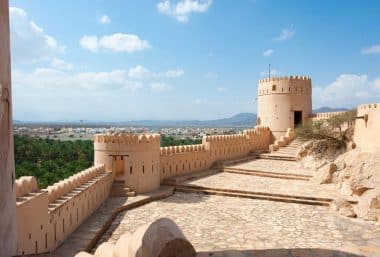Desert and great starry skies, these two belong together for very specific reasons. The desert is a place without air pollution and without artificial light. If you love stargazing, galaxies, the Milky Way or the rings of Saturn, then you are a stargazer and potential astro-tourist and then Oman is an interesting destination for you. During the pandemic, the possibility for Swiss citizens to enter Oman without a visa was abolished, but an electronic visa for Oman can be applied for at home via the Internet in ten minutes and the tourist visa allows travel of up to 30 days.
1. Stargazing: Contact with infinity
Through the gigantic seas of lights that are switched on every night in Europe, North America and Asia, through the fact that there are fewer and fewer areas unlit at night, human contact with stars, and this sense of infinity that goes with it, has been restricted. Stargazers know the feeling: in the face of the many stars, with the knowledge of the incredibly long distances between them, a feeling of modesty arises; man feels how tiny he and his home planet are in the infinite universe. Stargazing is meditative, almost mystical and healing against arrogance and self-centeredness. Due to the pandemic, which confined people to their homes, hobby astronomy has gained a lot of popularity as an activity that could also be practiced at home.
2. National parks are often good places for stargazing

Whether you observe with binoculars, with your own telescope, enjoy the atmosphere with the naked eye or travel to state or private observatories: a clear sky and darkness are the ingredients for unforgettable nights, because the universe is already there, even during the day, it just wants to be seen. It’s quite simple: you need as far away as possible from civilization with its light and air pollution. Oman, which, by the way, is also very suitable for a holiday with children The Rub al-Khali Desert, the largest sand desert in the world, which is partly located in Oman and protected as a national park, and mountains that allow stargazing even in the monsoon season because they are above the cloud cover, such as the 1600-meter-high Jebel Samhan in a national park near the coast of Dhofar. We present some of the best places for stargazing in Oman.
3. Stargazing in 1001 Nights
Camel caravans in the sandy desert, men in white robes with turbans, colorful crowds in the narrow streets of the souks, the Arab markets, and the mighty sultan in his magnificent palace: Oman is a journey into the stories of the thousand and one nights, well developed by tourists but not yet very frequented. The Sultanate of Oman, with its five million inhabitants, is sparsely populated and offers some places that are excellent for astro-tourism:
- The part of the Rub al-Khali Sand Desert that lies in Oman is protected as a national park. From Salalah, a coastal city in the south, you can book up to three-day excursions to the Rub Al Khali Desert with overnight stays in tents in Bedouin camps, where you can not only get an intimate insight into the world of the Bedouins, but also explore the spectacular starry skies. Nights in the desert are always a special experience, where the stars play an important role.
- Salalah, the capital of the huge, sparsely populated southern governorate of Dhofar, has become the starting point for stargazing tours. If you prefer more water after your desert excursion, then spend a few days at the beach at the remote Fazayah Beach, west of Salalah. The beach is best accessed by off-road vehicles. There are no houses, no electricity and great starry skies. In Salalah you can book tours with an overnight stay in a tent. Tours with overnight stays and meals are also offered to other beaches, such as the coastal towns of Hazid or Mirbat east of Salalah.
- The summit of Jebel Samhan lies above the clouds and – depending on the weather – the haze of the coast, making it perhaps the best tip for stargazers in the Salalah area. But the mountain range is also an experience during the day: The rugged mountainous region with wild, deep gorges is home to the last Arabian leopards, Arabian wolves, striped hyenas, Nubian ibexes and is sparsely overgrown with frankincense trees and acacias. The Jebel Samhan Nature Reserve covers over 4500 square kilometers. The viewpoints offer breathtaking views of the sea. The limestone cliffs that drop steeply towards the coast are the habitat of Arabian gazelles and Socotra cormorants. On cloudy days, you can look down on the clouds from there.
- In the north of the country, the
Hajar Mountains
, west of Muscat, which rise to over 2700 meters, offer the best conditions for unforgettable nights under the stars. Except for the wadis in the gorges, which are lined with lush palm belts, there is hardly any vegetation. The “Grand Canyon” of Oman, the Wadi Ghul, is worth a visit. There, the rock walls drop steeply up to 1000 meters towards the oasis. If you can afford it, book a few nights at Alila Jabal Akhdar, a Hyatt Group luxury hotel on Jabal al-Akhdar, where you can book star-gazings by the hour.
Oman is an experience from 1001 nights, which will give you relaxation, joy and soul nourishment during the day and night under its unique starry sky.


